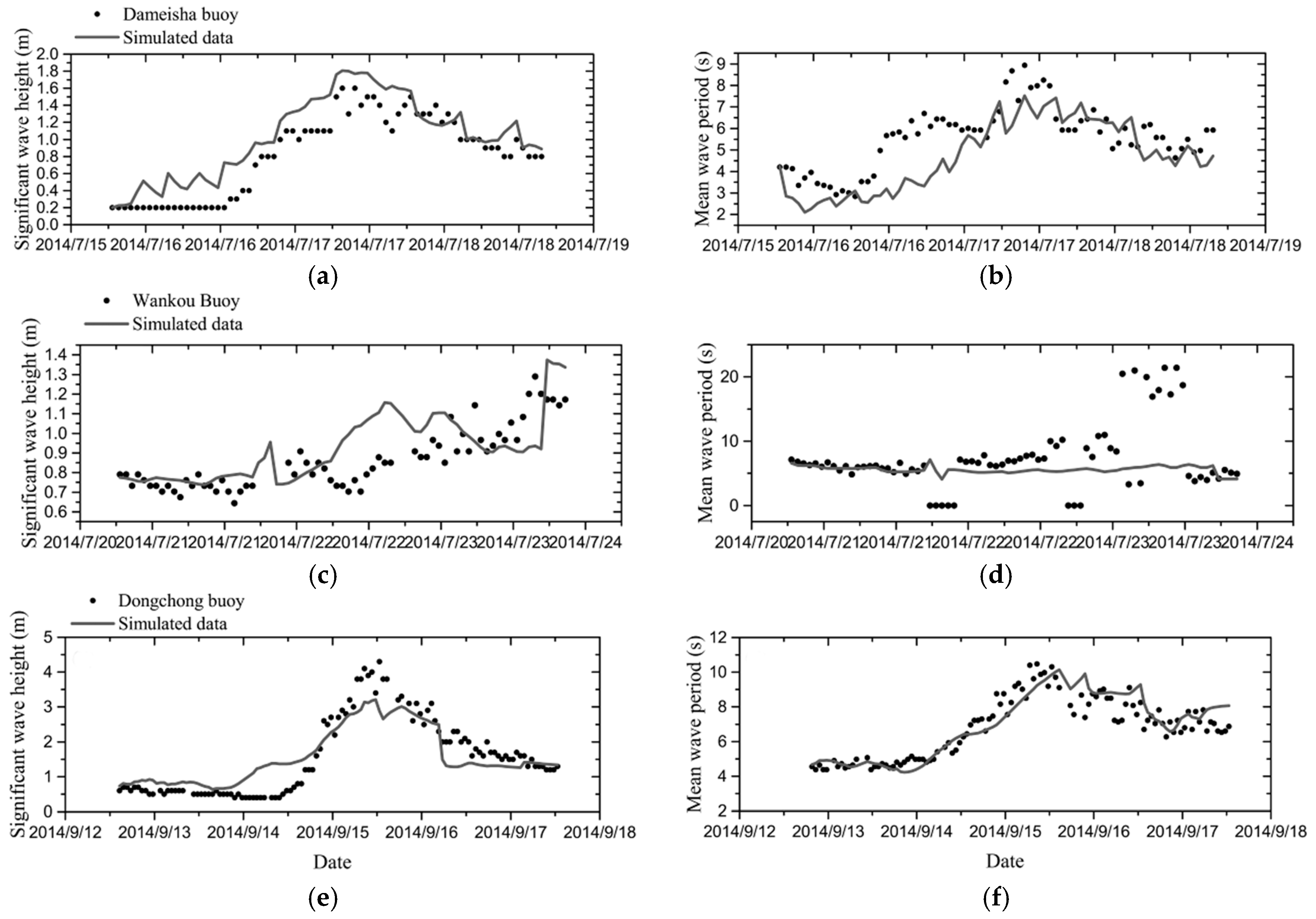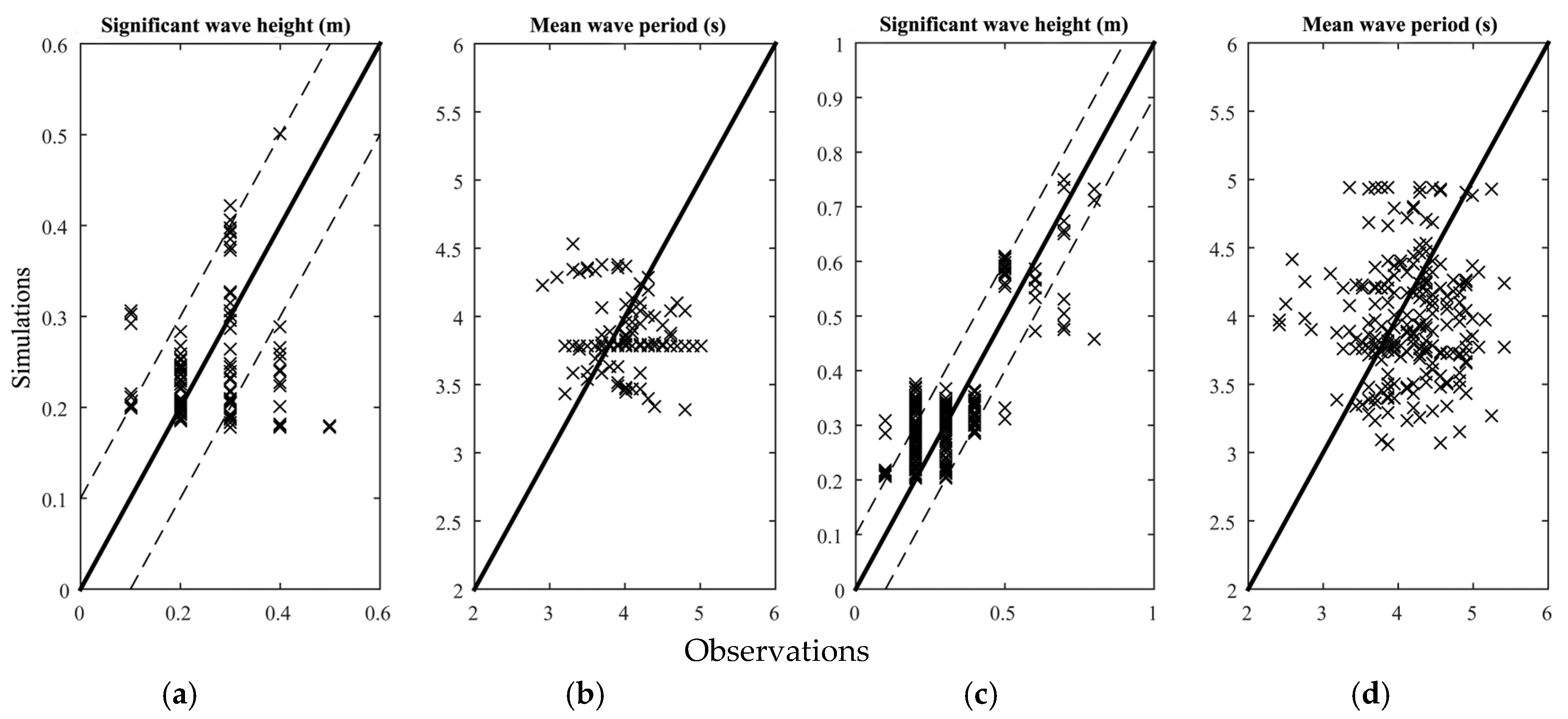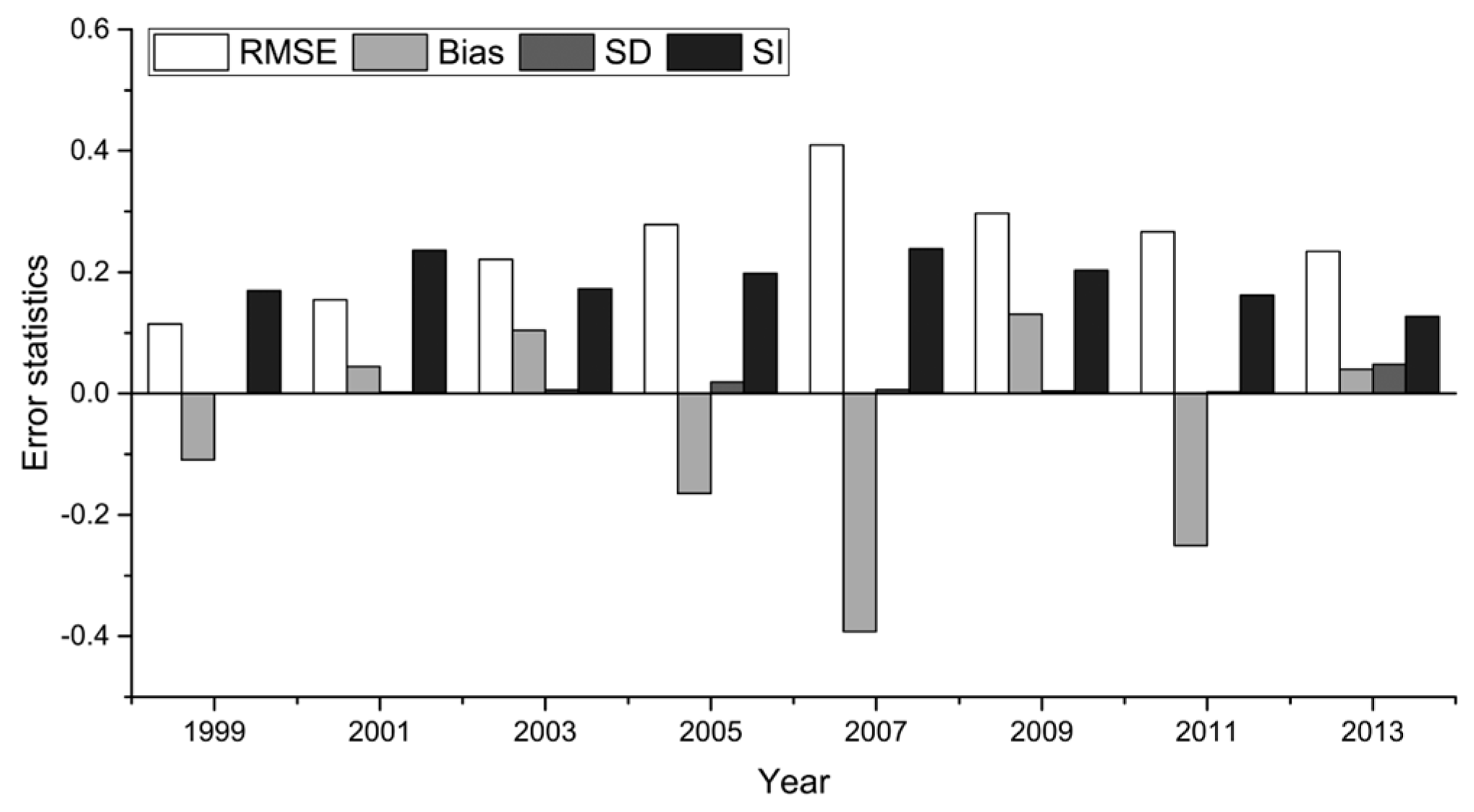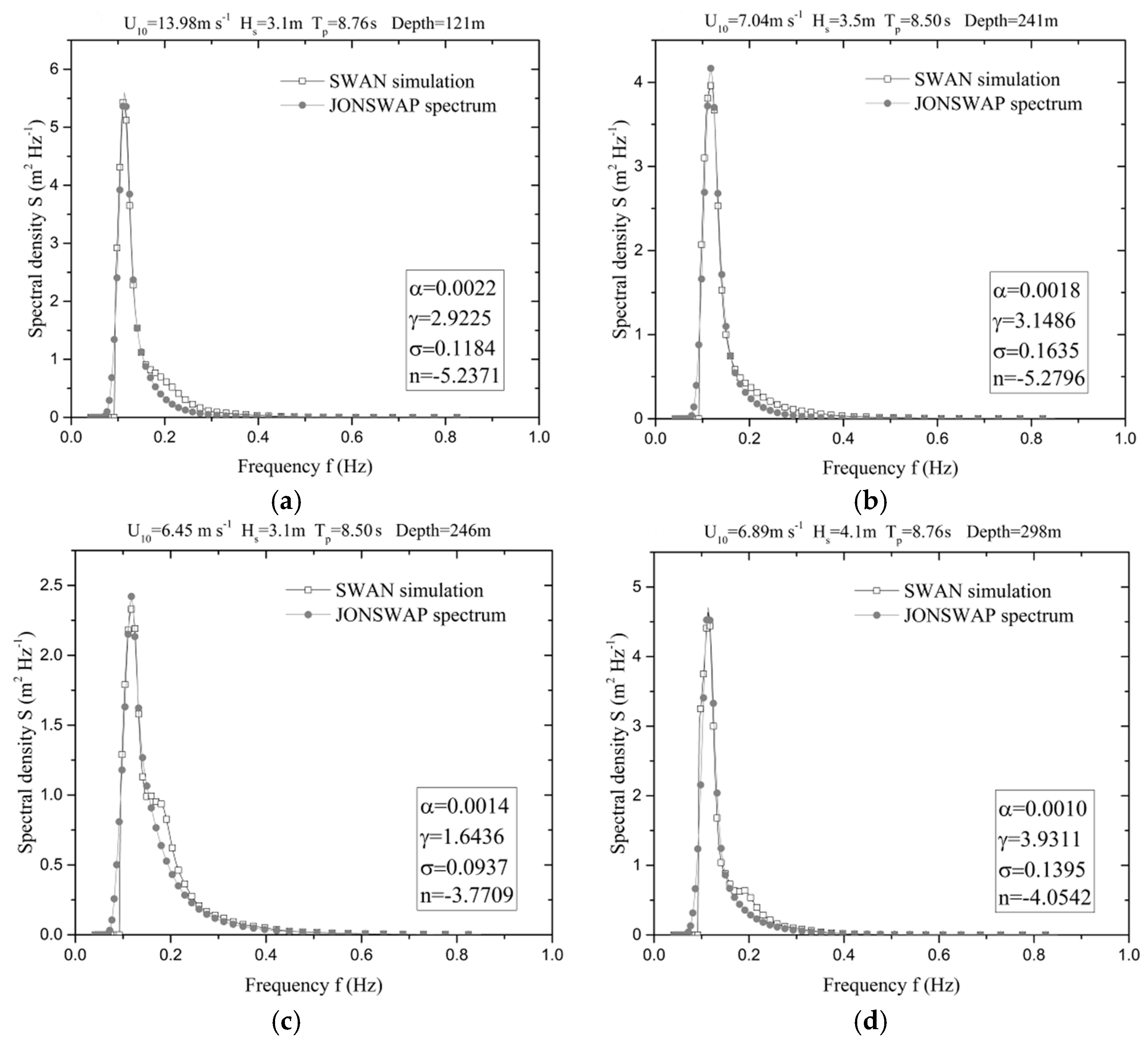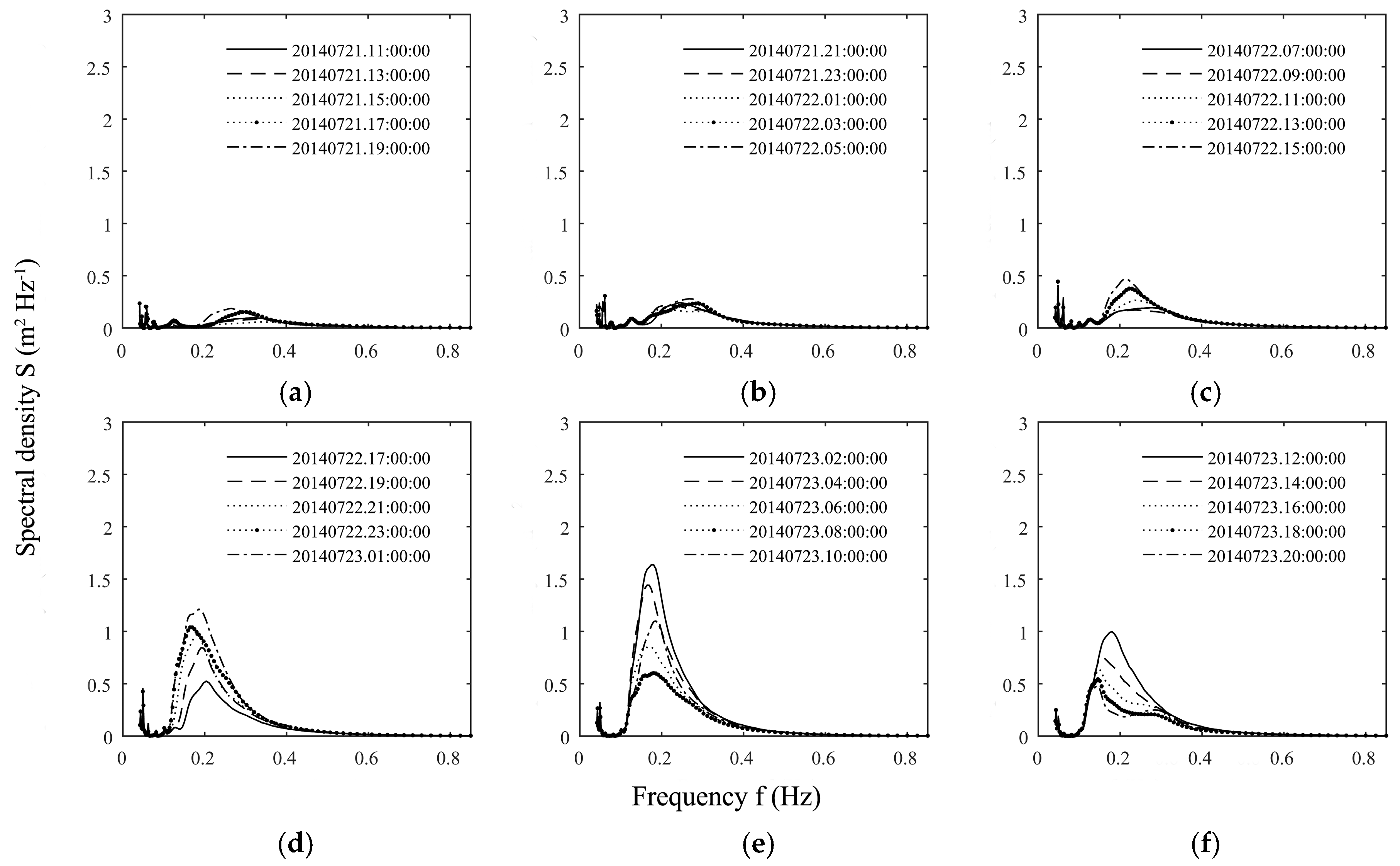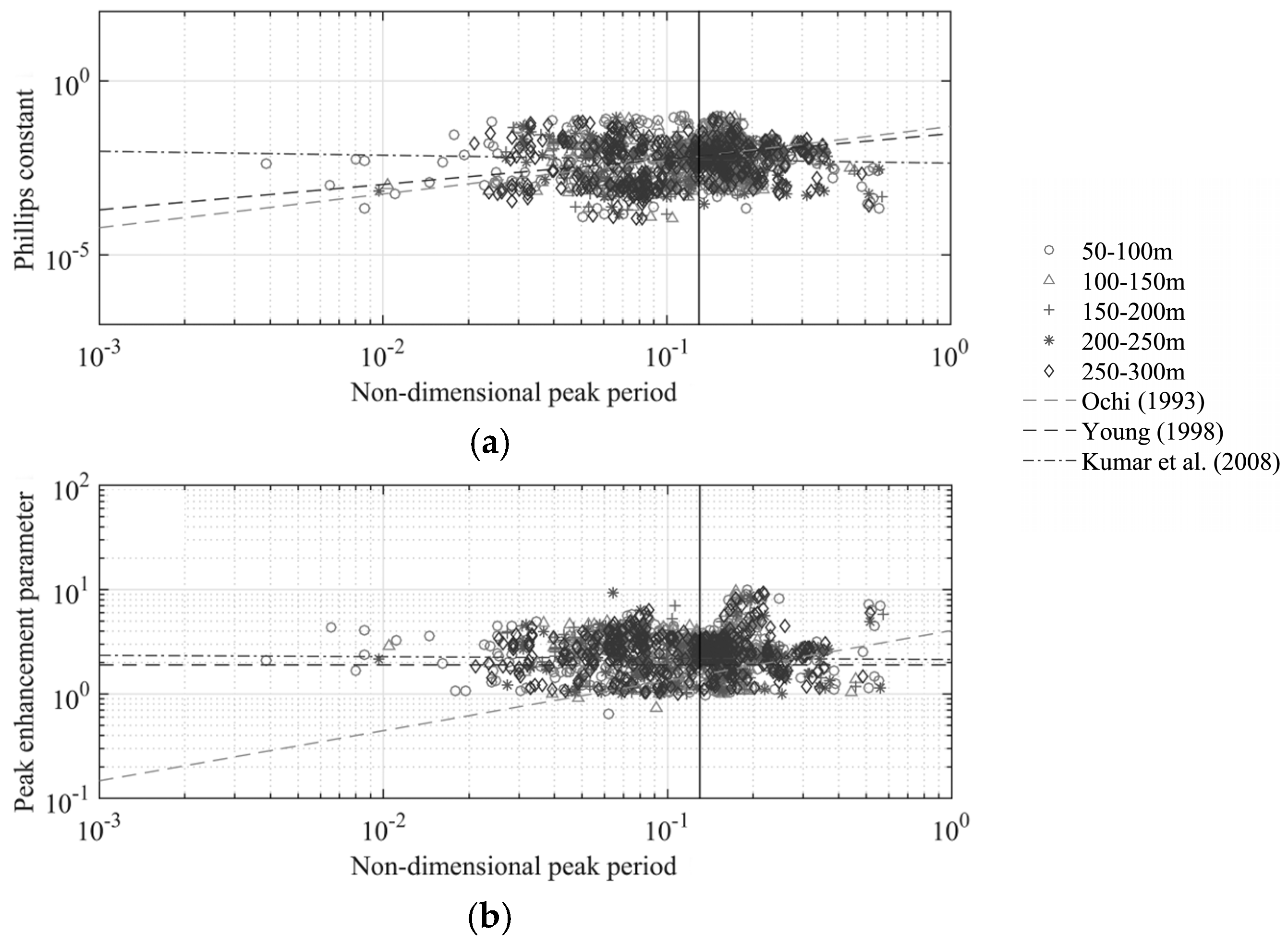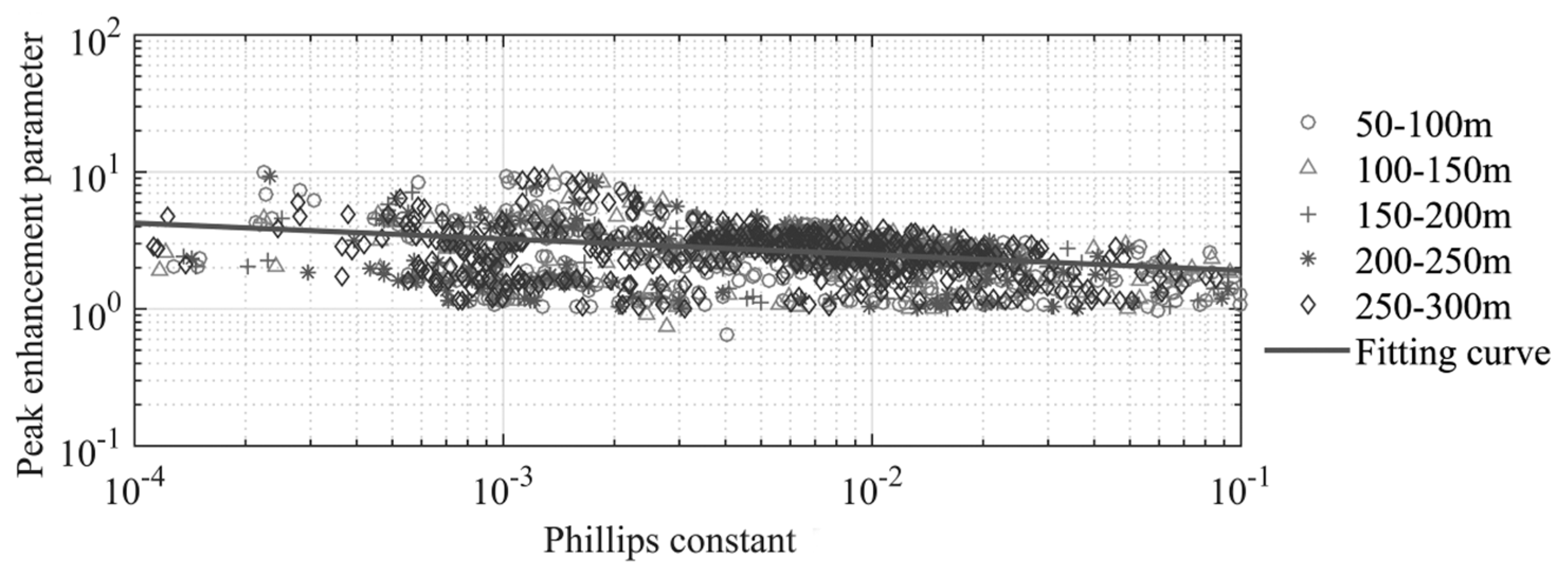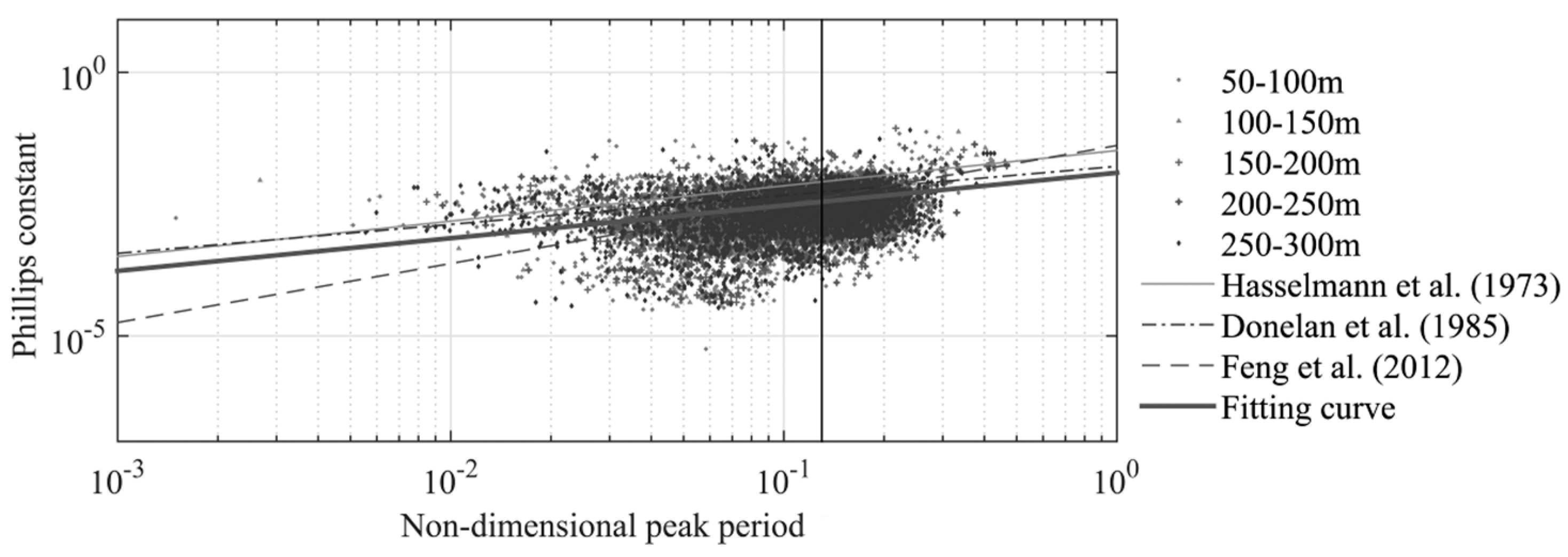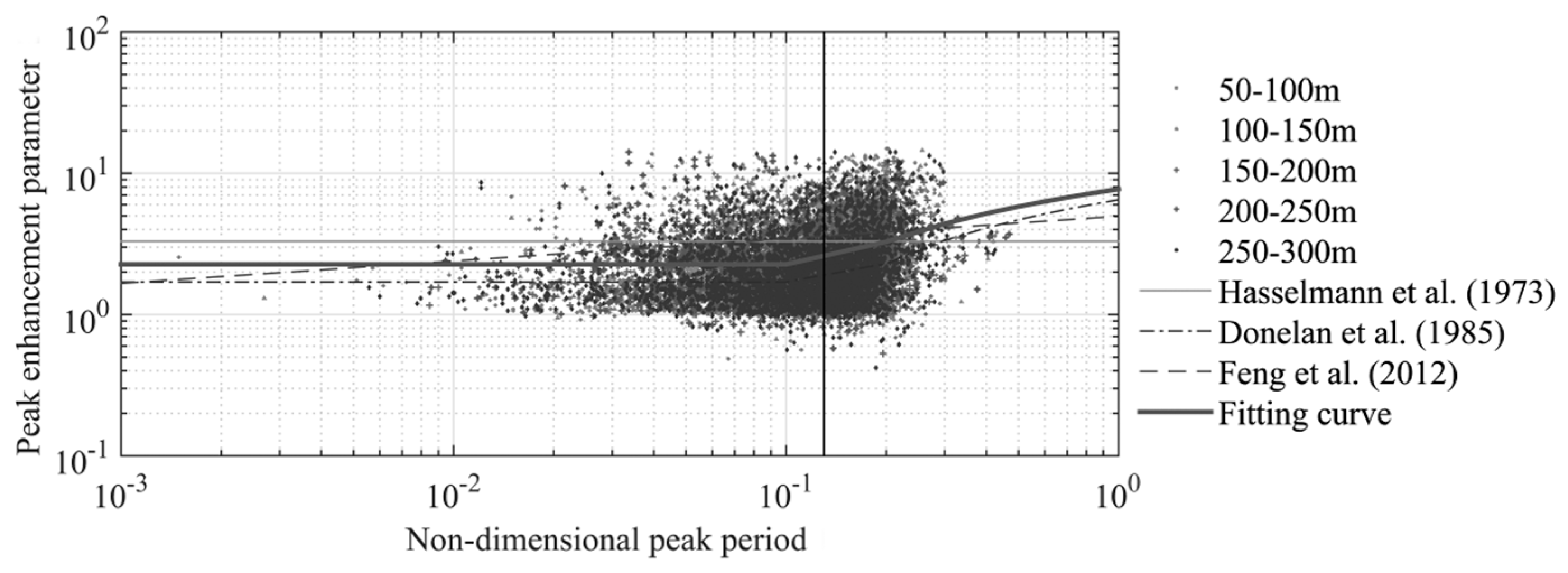Considering the prevalence and the flexibility of the JONSWAP spectrum model in the offshore structure design, it is postulated that the JONSWAP spectrum model is also applicable to show the wave field characteristics found in the South China Sea. The values of the key parameters shaping the JONSWAP spectrum, however, should be revised to reflect the geographic, hydrological, and meteorological differences between the South China Sea and the North Sea, from where the observations are obtained to establish the JONSWAP spectrum model. Therefore, the discussion on the wave field characteristics found from analyzing the numerical simulation results focuses on the values of the key parameters of the JONSWAP spectrum model. In detail, the wave spectra output from the SWAN simulation are fitted to the JONSWAP spectrum model to derive the values of and . Meanwhile, the values of and are estimated using the empirical functions proposed by previous scholars. By comparing the best-fitted and estimated and , the applicability of the JONSWAP spectrum model is discussed.
4.1. Post-Processing of the Simulation Results
In order to focus on the general shape, instead of the absolute values, of the wave spectra, the non-dimensional peak period (
) and energy
are introduced, which are defined as:
In Equation (15),
is the wind speed at the 10 m level. Following Hasselmann et al. [
11], the relation between
and
can be modeled as:
Using the
and
defined above, the equations proposed by previous scholars to calculate the JONSWAP spectrum parameters of
and
can be normalized. In the normalization, the
, which is directly output from the SWAN model, should be transferred to the
, and the widely adopted relation [
46] is employed in the present study to transfer
to
:
Since the numerical simulation yields the wave field spectral characteristics under both typhoon and non-typhoon conditions, the equations provided in the literatures are categorized into two groups, corresponding to typhoon and non-typhoon situations respectively.
- (a)
Group 1 (corresponding to the typhoon situation)
Kumar et al. (2008) [
26]:
- (b)
Group 2 (corresponding to the non-typhoon situation)
Donelan et al. (1985) [
15]:
From the Equations (18)–(27), it can be discerned that the calculations of and weakly depend on the mean wind speeds at 10 m level. The influence of is, however, limited given the power indices appearing with in these equations. Thus, the temporally averaged wind speeds, corresponding to each simulation case, are used to estimate and according to Equations (18)–(27).
It is reasonable to assume that the water-depth has appreciable impact on the validity of the JONSWAP spectrum model and the values of its key parameters. Therefore, the wave spectra outputs from the SWAN simulation are binned according to the water-depth with a step size of (, , , and ) to explore the impact of the water-depth.
By fitting the simulated wave spectra extracted from the SWAN simulation to the universal form of the JONSWAP spectrum model (Equation (3)), the key parameters
and
are derived. Afterwards, the comparison between the derived
and
to the estimations calculated according to Equations (18)–(27) shows the values of the key parameters of the JONSWAP spectrum applicable to describe the wave characteristics found in the South China Sea. In terms of fitting the simulated wave spectra to the JONSWAP spectrum model, the Levenberg-Marquardt algorithm [
47,
48] is adopted to solve the nonlinear least squares problem. Several fitting results are shown in
Figure 5 to illustrate the feasibility of using the JONSWAP spectrum, with best-fitted key parameters, to model the wave spectra extracted from the SWAN simulation results. From
Figure 5, it is discerned that the JONSWAP spectrum approaches the SWAN simulation results by adjusting the four parameters (
,
,
and
) under both typhoon and non-typhoon conditions.
4.2. Typhoon Condition
Before systematically comparing the key parameters of the JONSWAP spectrum (
and
) derived from fitting the SWAN simulation results and estimated according Equations (18)–(27), it is worthwhile to examine the evolution of the wave spectra in the approach of a typhoon.
Figure 6 presents the SWAN simulated wave spectra at the position of the Wankou buoy during the passage of Typhoon Matmo. A clear increasing-decreasing trend is observed from
Figure 6. More specifically, the wave spectral density in
Figure 6 increases when the Typhoon Matmo approaches the position of the Wankou buoy and reaches the peak at 02:00 (UTC) on 23 July. At the peak, the
Hs,
, and spectral density reaches
,
and
respectively. Afterwards, the strong wind field of Typhoon Matmo swept the Wankou buoy and moved northwards, which leads to the decrease of the wave spectral density. Actually, the wave spectral density reduces to the normal level at 07:00 (UTC) on 23 July. The simulated wave spectra corresponding to other typhoons are similar in shapes as shown in
Figure 6, and therefore are omitted for brevity.
In the increasing-decreasing trend shown in
Figure 6, two peaks appear in the wave spectral density curves, which implies co-existing wind-induced waves and swells. When the Typhoon Matmo approaches, the peak corresponding to the wind-induced wave becomes prominent when compared to the swell peak. In fact, the swell height reaches
at 02:00 (UTC) on 23 July, which only takes
of the total wave energy. Such findings are in line with the conclusions derived by previous scholars. Young [
16] indicated that within the radius of eight times the RMW (radius to the maximum wind) of a typhoon wind field, the uni-modal spectrum occurs in most cases. Other researches concurred that the wave fields under the influence of typhoons are commonly uni-modal and the wind-induced wave dominates the wave energy. In fact, previous scholars concluded that the wind-induced wave leads to an essentially uni-modal wave-spectrum when the
Hs varies from
[
26], the wind speed exceeds
[
49], or the root-mean-squared wave height exceeds
[
27]. In the present study, the uni-modal spectra occur in most cases when the value of
Hs exceeds
under typhoon condition. Consequently, the
Hs is used as an indicator to identify if a certain wave spectrum output from the SWAN model is under typhoon influence. Among
wave spectra derived from the SWAN simulation of typhoon cases, only
spectra corresponding to the
Hs larger than
were selected for further investigations.
By analyzing the
Hs and
Tp of the selected
wave spectra, it was found that the water-depth has appreciable impacts on the spectral characteristics of waves induced by typhoon winds. In fact, both the
Hs and
Tp increase with the water-depth. One plausible explanation is that the dissipation of wave energies caused by bottom frictions and waver breakings decreases in deeper waters. In order to investigate the influence of the water-depth on the wave spectra in a more systematic way, the key parameters of the JONSWAP spectrum (
,
,
and
) derived from fitting the SWAN simulated spectra, corresponding to different water-depth bins, are presented in
Table 10. It is evident from the table that
decreases with the increasing water-depth under typhoon condition. In general,
appears lower than traditional values varying from
, which indicates the meteorological condition (higher wind speed and larger wind fetch) keep
into a lower range around
. The variation of
is not obvious with water depth ranging from
to
. Kumar et al. [
26] concluded that the water-depth does not have significant impact on the high frequency tail decay parameter
when the water-depth is in the range of
. The variation of
revealed in
Table 10 supports such a conclusion as the value of
stays around a constant of
for the waves in the South China Sea under typhoon influence. Similarly, it has been found that the water-depth has negligible influence on the values of
and
, which substantiates that the water-depth and typhoon environment have a weak influence on the shape of wave spectra [
21]. On the basis of above analyses, among the key parameters shaping the JONSWAP spectrum, only the Phillips constant
, representing the magnitude of the total wave energy, is necessary to be adjusted according to the water depth. In terms of using the JONSWAP spectrum model in the design of offshore wind turbines, designers and engineers are suggested to refer to
Table 10 for a crude estimation.
In terms of the variation of
with the
,
Figure 7a presents the results from fitting the SWAN simulated wave spectra to the JONSWAP spectrum model and the estimations made according to the equations provided in literatures. It should be noted that,
less than
means that the propagation speed of waves at the peak frequency is faster than the local wind speed. In such case, the wave energy is not input from local winds but mainly from swells. Therefore, the black vertical lines shown in
Figure 7, Figures 9 and 10 represent the boundary separating the wind-induced and swell-dominated waves. It is clear from
Figure 7a that, expect for Equation (22) provided by Kumar et al. (2008) [
26], Equations (18) and (20) proposed by Ochi (1993) [
23] and Young (1998) [
16] yield reasonable estimates of
given the
. Similar to
Figure 7a, the variation of
with
is plotted in
Figure 7b. It is evident that significant dispersions appear in the figure, which is also recorded by previous scholars, revealing that
only weakly depends on wave periods [
18]. In fact, Young suggested to model
as a constant of
under typhoon influences in response to the scattering of
observed in different cases.
In analyzing the variations of
and
with
, however, it has been found that an approximate linear relation exists between
and
. In fact, it seems that
linearly decreases with increasing
, as shown in
Figure 8. The straight line shown in
Figure 8 indicates the linear regression results, which can be expressed as:
In summary, it is suggested that Equations (18) and (20) proposed by Ochi (1993) [
23] or Young (1998) [
16] are adequate to estimate
for the waves in the South China Sea under typhoon influences.
To provide a crude estimation of
for engineering application, designers and engineers are suggested to look for
according to the water-depth in
Table 10. The estimation of
, on the other hand, should be based on its relation with
as shown in Equation (28). As regards the values of
and
, two constants are suggested (
and
, respectively). By comparing the maximum spectral density and spectral zero moment of the wave spectra derived from the SWAN simulation and calculating according to the JONSWAP spectrum model using the parameters proposed by previous scholars and in the present study, the suggestions made above are evaluated.
Table 11 presents the
RMSE and
Bias of the maximum spectral densities and spectral zero moments calculated differently. It is evident from the table that all the estimations yield reasonable results in terms of the maximum spectral density. As for the spectral zero moment, the estimations made according to the suggestion given in the present study outperform all other estimations to produce the lowest
RMSE (
) and
Bias (
).
4.3. Non-Typhoon Condition
Because the JONSWAP model is only suitable for describing the uni-modal spectrum, discussing the values of its key parameters based on fitting bi-modal spectra to the JONSWAP model is pointless. Therefore, it is necessary to rule out the bi-modal spectra from the SWAN simulation results. Comparing to the waves under typhoon conditions, the variation of
Hs under non-typhoon condition has a narrower range from
to
, and the shape of wave spectra is not tightly related to the
Hs as in the typhoon case. Therefore, it is not feasible to identify the uni-modal spectrum according solely to the
Hs in the non-typhoon case. A simple algorithm is then designed to pick out the spectral shapes with one extreme point based on the fact that uni-model wave spectrum has the sole peak. Through screening,
uni-model spectra are selected from
wave spectra output from the SWAN simulation. Using also the Levenberg-Marquardt algorithm, the selected spectra are fitted to the JONSWAP spectrum model. The same as in the discussion on the typhoon cases, the key parameters of
,
,
and
are derived from the fitting process. The derived parameters are summarized in
Table 12.
Comparing to the variation of
for typhoon cases in
Table 10, the constant of 0.0034 shown in the column of
in
Table 12 reflects the constant wave energy in the calm sea state, which implies that a constant
is adequate to yield appropriate JONSWAP spectrum for different water-depths. In fact, other parameters
,
and
also relatively keep constant (as
and
respectively) when the water-depth varies. Such a finding indicates that the water-depth has negligible influence on the shape of the wave spectrum under the non-typhoon condition. It is argued that the stable spectral shape is a result of relatively constant wind energy input and the weak dissipations caused by water breakings and bottom frictions. Furthermore, the values of
and
are different from those under the typhoon condition. More specifically,
reaches
implying a wider peak in the wave spectrum when comparing with the value of
under the typhoon condition, similar to the results from the work of Young and Verhagen [
24].
, on the other hand, keeps a larger value (
), which is close to the modified value of
by Donelan et al. [
15].
As regards the variations of
and
with the
,
Figure 9 and
Figure 10 show the values derived from the SWAN simulation results and estimated according to the equations proposed in literatures.
It has been discerned from the figure that different Equations (18)–(27) yield similar estimates, in the sense of approximating the values derived from the fitting process. In fact, the equations provided in literatures all take the form of:
Their differences concern only the model constants of
and
. By fitting the derived
and calculated
to Equation (29), the best fitted values of
and
are suggested in the present study as,
and
. Combining with Equation (15), it is suggested, based on the results of the present study, that
can be estimated as:
Similarly,
Figure 9 and
Figure 10 show the values of
calculated based on the SWAN simulation results and estimated using the equations provided in literatures (Equations (18)–(27)). From the figure, a slight increasing trend is found when examining the variation of
with
. While Hasselmann et al. [
11] modeled
as a constant of
based on their observation, the piecewise function proposed by Donelan et al. [
15] is found more applicable to describe the slight increasing trend of
observed in
Figure 10. Adapted from the formula proposed by Donelan et al. [
15], it is suggested that
can be expressed as a piecewise function of
as:
As regards the values of and , two constants ( and , respectively) are suggested based on examining the values derived from the fitting process.
In summary, Equations (30) and (31), and two constants are suggested in the present study to model the key parameters of the JONSWAP spectrum (
,
,
and
) in order to make it applicable to describe wave characteristics in the South China Sea under non-typhoon condition. As in the investigation concerning the typhoon case, the maximum spectral densities and spectral zero moments calculated based on the SWAN-simulated wave spectra and the JONSWAP spectrum model with the key parameters estimated using different methods are compared in
Table 13.
It is clear from the table that the estimations of the key parameters proposed in the present study produce the lowest RMSE and Bias, indicating that the JONSWAP spectrum model should be revised as suggested in the present study to be applicable for describing wave characteristics in the South China Sea.

